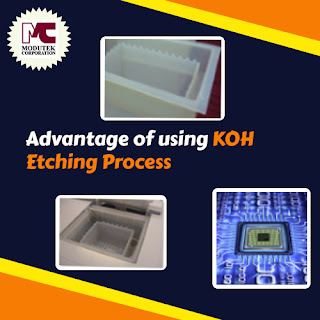The KOH
etching process uses a solution of potassium hydroxide to etch silicon
wafers and produce microscopic structures in the silicon. In subsequent
processing steps, microscopic structures are followed to manufacture integrated
circuits, processors, and other electronic devices.
One of the advantages of using KOH etching is that it is relatively safe compared to other etching processes. It also etches silicon fast and can be precisely controlled. These factors are important especially for batch processing where the process step must be precisely done repeatedly. Unlike other chemical processes that are required for specific cleaning and etching steps, KOH is ideal for general silicon etching.
In preparing the KOH solution, KOH is added to water in an etching tank made of a material that is impervious to aggressive chemicals. Silicon wafers are masked with silicon nitride or silicon dioxide, substances that KOH does not etch. Once the wafers are immersed in the KOH solution, the silicon is removed from the areas that are not masked by the chemical action of the KOH solution.
The etch rate can be controlled by changing the concentration of the solution and by changing the temperature. Other factors that influence the etch rate are the crystal lattice planes of the silicon and the presence of boron doping.
Because the KOH etching process is very sensitive to temperature, it is important to maintain the temperature at the exact set point. That’s why the temperature controller should be accurate during the process and from one batch to the next. Tight control during the etching process ensures that the etch rate remains constant while maintaining precisely the same temperature for a given setpoint from one batch to the next. This ensures accurate reproducibility of process conditions and identical results across different batches.
One of the advantages of using KOH etching is that it is relatively safe compared to other etching processes. It also etches silicon fast and can be precisely controlled. These factors are important especially for batch processing where the process step must be precisely done repeatedly. Unlike other chemical processes that are required for specific cleaning and etching steps, KOH is ideal for general silicon etching.
In preparing the KOH solution, KOH is added to water in an etching tank made of a material that is impervious to aggressive chemicals. Silicon wafers are masked with silicon nitride or silicon dioxide, substances that KOH does not etch. Once the wafers are immersed in the KOH solution, the silicon is removed from the areas that are not masked by the chemical action of the KOH solution.
The etch rate can be controlled by changing the concentration of the solution and by changing the temperature. Other factors that influence the etch rate are the crystal lattice planes of the silicon and the presence of boron doping.
Because the KOH etching process is very sensitive to temperature, it is important to maintain the temperature at the exact set point. That’s why the temperature controller should be accurate during the process and from one batch to the next. Tight control during the etching process ensures that the etch rate remains constant while maintaining precisely the same temperature for a given setpoint from one batch to the next. This ensures accurate reproducibility of process conditions and identical results across different batches.
Modutek’s
Teflon tanks allow operators to benefit from all the advantages of the KOH
etching process. The tanks are specifically designed for KOH etching and
feature a wide temperature range, tight temperature control, and rapid heating.
Custom tank sizes are available and custom installations can be done to fit any
new or existing wet bench application.
Read the complete article “Advantages
of Using the KOH Etching Process” for more details on how Modutek’s Teflon
tanks can help operators get all the benefits of KOH etching. For a free
consultation or quote contact Modutek at 866–803–1533 or email modutek@modutek.com.


No comments:
Post a Comment